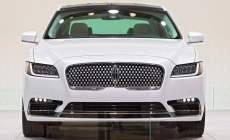
Jon Henrich, new product development manager at Ford Motor Credit speaks to Jonathan Minter about how Lincoln Finance is using the carrot as well as the stick when it comes to mileage limits
Lincoln Motor Company, the luxury US brand of Ford, recently launched Lincoln Miles, a pilot scheme giving finance users credit towards their next Lincoln if they finish their lease under the pre agreed milage. Motor Finance spoke to Jon Henrich about how car underutilisation could be used to drive loyalty.
MF: Could you explain the Lincoln Miles concept?
John Henrich: The concept of Lincoln Miles is to leverage connected vehicles. Lincolns that have an embedded modem can offer an experience whereby clients can track their actual mileage on a daily basis, and when they come through to the end of the lease contract with us, if they either lease or buy another Lincoln vehicle, they can earn a rebate of between $100 (£68) and $1,000. It’s essentially paying them for underutilisation.
If I back up a stage, when a client chooses a vehicle, at inception, they choose the mileage they anticipate they’ll drive.
One of the known parts of pain when paying for a client generally on lease is you’re generally doing the best you can to estimate your mileage upfront, but whether you actually drive those miles or drive less than that, we’re creating a programme that takes away that mileage and anxiety.
How well do you really know your competitors?
Access the most comprehensive Company Profiles on the market, powered by GlobalData. Save hours of research. Gain competitive edge.

Thank you!
Your download email will arrive shortly
Not ready to buy yet? Download a free sample
We are confident about the unique quality of our Company Profiles. However, we want you to make the most beneficial decision for your business, so we offer a free sample that you can download by submitting the below form
By GlobalDataIt gives them real-time feedback on their mileage, and allows them to earn a rebate for underutilisation. And for the purposes of this pilot, even if you go over the mileage, you can still earn a rebate towards your next Lincoln.
Would that cover some of the charges for going over an agreed mileage?
Henrich: Not directly. It isn’t an offset to your over mileage charges, but it is an offset to your next Lincoln. So technically it is a different transaction.
Would something like this have been possible without modern car connectivity?
Henrich: Possible, but not as elegant. There is the possibility of aftermarket plug-in devices, which can also be used to track mileage and so on. But for the purposes of this experiment, we really wanted to leverage the new technology which is being embedded in Lincolns in the US.
And we found this was a really good way to encourage clients to engage with their vehicle. We’ve seen clients, because of this programme, being more active with their modem, activating their modem, and clearly engaging with the experience.
So you can monitor driver behaviour?
Henrich: We’re not monitoring driver behaviour at all. We’re very careful with the data. Mileage is the only data we’re collecting for this experiment, we don’t collect any of the other data.
But what we can tell is that, of the people we solicited to join this programme, we know how many of them had already activated their modem, versus those who hadn’t.
We could then surmise that, of those who had joined the programme, we could tell who had activated the modem.
How many people did you reach out to, and was there a logic behind those you chose?
Henrich: We solicited just under 4,000 clients to participate. The most important part in choosing was that they were a Lincoln Automotive Financial Services client already, they had a Lincoln that had an embedded modem. And we wanted them to have at least 10 payments left.
Would this scheme work for other types of finance?
Henrich: To the extent that you could use mileage underutilisation as a potential way to drive loyalty, it would make sense. At the moment it’s so early that we haven’t really learned that part yet.
The time horizon for this experiment and the research will go on for a couple of years as we see these leases terminate and watch the client’s behaviour.
Would this work for older vehicles?
Henrich: We’re reliant on some sort of connected technology in vehicles. As you move into older vehicles you’re less likely to have an embedded modem, so you’ll have to have some technical solution to overcome that.
There’s a lot of talk of a move from ownership to usage models. Is this an example of a move in that direction?
Henrich: Not directly, but we have that in mind. If you think about what a lease is today, a lease is today’s version of usership. You’re committed to use and pay for the vehicle for two or three years in the US, and at the end you need to purchase or return that vehicle. We saw this as a way to enhance that experience by creating more interaction during the time of that lease with the vehicle, with the modem, and again address what we call mileage anxiety.
How much of an issue is mileage anxiety?
Henrich: We solicit feedback from our customers and clients all the time. This shows us that one of the things lessees and prospective lessees worry about is mileage – whether they drive more miles than they chose upfront, and how much will it cost them.
On the flip side, there’s the problem where they drive fewer miles. Should they get some benefit for that? With Lincoln Miles we’re providing some benefits to underutilisation.
We’ve tried to build a really engaging mobile app and experience for them. This also estimates what their lease-end miles will be, so there’s a little bit of gamification.
Does this add any risk to your book at all?
Henrich: No, we don’t see this as having a risk bearing. These are lessees that we had already in our portfolio.
They’re essentially going to drive the way they are going to drive, and we’ll see if they’ll change their behaviour because of this, but it’s not our going in assumption.
One worry in the UK is customers altering cars’ mileages to evade charges. Does the modem technology remove that worry?
Henrich: Yes. We’re very comfortable that the modem is reporting accurately. It’s part of the modem design, and it’s part of the testing we did before the programme launched.
I know it’s early, but do you have any future plans for this?
Henrich: It’s too early to say. The enrolment is still open [Ed’s note: it closed after the interview was conducted].
We’ve learned a lot in building it – a lot about how to build a mobile experience, how to connect the data, and a great deal around the architecture, but it’s really too early to say whether this is actually creating a more engaging client experience, or loyalty.
The answer right now is wait and see, but we’ll certainly consider it in the future if it’s successful.







